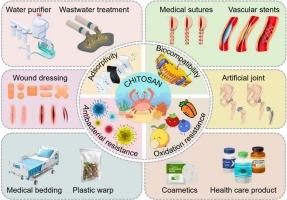Synthesis and application studies of chitosan nanofibers
IF 8.5
1区 化学
Q1 BIOCHEMISTRY & MOLECULAR BIOLOGY
International Journal of Biological Macromolecules
Pub Date : 2025-10-08
DOI:10.1016/j.ijbiomac.2025.148173
引用次数: 0
Abstract
Chitosan (CS), as one of the widely sourced biodegradable biopolymers, shows great potential due to its excellent physicochemical properties. However, the low mechanical strength, limited inherent functionality, and small specific surface area of native CS restrict its broader application. Therefore, this paper presents advances in the preparation and application of CS-based electrostatic spinning to address above shortcomings. CS nanofiber with antimicrobial, antioxidant and biocompatible properties can be additionally endowed with high specific surface area, high strength and multiple active sites by electrostatic spinning technique. This work focuses on three main aspects: the extraction process of CS, and the effect of the electrostatic spinning preparation process on the properties of nanofibers, as well as the progress of CS-based modified fibers obtained by electrostatic spinning for applications in biomedicine, environmental protection and food packaging. Meanwhile, the challenges in large-scale production and performance optimization of CS nanofibrous materials are also analyzed. But with continuous progress in research and technology, we believe that CS electrospun nanofibers are expected to play an important role in driving technological innovation.

壳聚糖纳米纤维的合成及应用研究
壳聚糖(CS)作为一种应用广泛的生物降解高分子材料,因其优异的物理化学性能而显示出巨大的应用潜力。然而,天然CS机械强度低,固有功能有限,比表面积小,限制了其更广泛的应用。因此,本文介绍了cs基静电纺丝的制备和应用进展,以解决上述不足。采用静电纺丝技术制备的CS纳米纤维具有抗菌、抗氧化和生物相容性等特性,具有高比表面积、高强度和多活性位点。本文主要从三个方面对CS的提取工艺、静电纺丝制备工艺对纳米纤维性能的影响以及静电纺丝制备的CS基改性纤维在生物医药、环保和食品包装等方面的应用进展进行了综述。同时,分析了CS纳米纤维材料在规模化生产和性能优化方面面临的挑战。但随着研究和技术的不断进步,我们相信CS静电纺纳米纤维有望在推动技术创新方面发挥重要作用。
本文章由计算机程序翻译,如有差异,请以英文原文为准。
求助全文
约1分钟内获得全文
求助全文
来源期刊
CiteScore
13.70
自引率
9.80%
发文量
2728
审稿时长
64 days
期刊介绍:
The International Journal of Biological Macromolecules is a well-established international journal dedicated to research on the chemical and biological aspects of natural macromolecules. Focusing on proteins, macromolecular carbohydrates, glycoproteins, proteoglycans, lignins, biological poly-acids, and nucleic acids, the journal presents the latest findings in molecular structure, properties, biological activities, interactions, modifications, and functional properties. Papers must offer new and novel insights, encompassing related model systems, structural conformational studies, theoretical developments, and analytical techniques. Each paper is required to primarily focus on at least one named biological macromolecule, reflected in the title, abstract, and text.

 求助内容:
求助内容: 应助结果提醒方式:
应助结果提醒方式:


